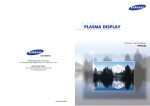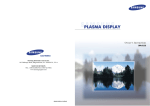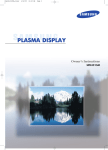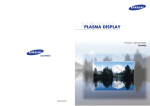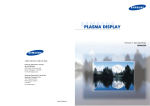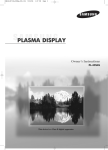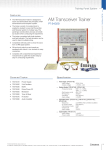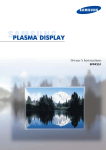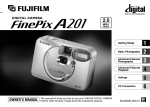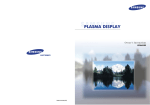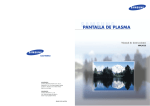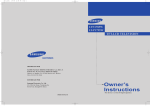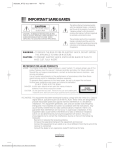Download Samsung Tantus HPM5027 User's Manual
Transcript
Owner’s Instructions HPM5027 BN68-00327A-00(ENG) Warning! Important Safety Instructions Thank You for Choosing Samsung Thank you for choosing Samsung! Your new Samsung product represents the latest in television technology. We designed it with easy-to-use on-screen menus and closed captioning capabilities, making it one of the best products in its class. We are proud to offer you a product that will provide convenient, dependable service and enjoyment for years to come. CAUTION: TO REDUCE THE RISK OF ELECTRIC SHOCK, DO NOT REMOVE COVER (OR BACK). NO USER SERVICEABLE PARTS INSIDE. REFER SERVICING TO QUALIFIED SERVICE PERSONNEL. This symbol indicates high voltage is present inside. It is dangerous to make any kind of contact with any inside part of this product. Important Safety Information Always be careful when using your Monitor. To reduce the risk of fire, electrical shock, and other injuries, keep these safety precautions in mind when installing, using, and maintaining your machine. • Read all safety and operating instructions before operating your Monitor. • Keep the safety and operating instructions for future reference. This symbol alerts you that important literature concerning operation and maintenance has been included with this product. • Heed all warnings on the Monitor and in the operating instructions. • Follow all operating and use instructions. Note to CATV system installer: This reminder is provided to call CATV system installer's attention to Article 820-40 of the National Electrical Code (Section 54 of Canadian Electrical Code, Part I), that provides guidelines for proper grounding and, in particular, specifies that the cable ground shall be connected to the grounding system of the building as close to the point of cable entry as practical. • Unplug the Monitor from the wall outlet before cleaning. Use a damp cloth; do not use liquid or aerosol cleaners. • Never add any attachments and/or equipment without approval of the manufacturer. Such additions can increase the risk of fire, electric shock, or other personal injury. Caution: FCC/CSA regulations state that any unauthorized changes or modifications to this equipment may void the user's authority to operate it. • Do not use the Monitor where contact with or immersion in water is a possibility, such as near bath tubs, sinks, washing machines, swimming pools, etc. Caution: To prevent electric shock, match the wide blade of plug to the wide slot, and fully insert the plug. • Do not place the Monitor on an unstable cart, stand, tripod, bracket, table, or floor where it can fall. A falling Monitor can cause serious injury to a child or adult, and serious damage to the appliance. Use only with a cart, stand, tripod, bracket, or table recommended by the manufacturer or sold with the Monitor. Follow the manufacturer's instructions when mounting the unit, and use a mounting accessory recommended by the manufacturer. Move the Monitor and cart with care. Quick stops, excessive force, and uneven surfaces can make the unit and cart unsteady and likely to overturn. Attention: pour eviter les chocs electriques, introduire la lame le plus large de la fiche dans la borne correspondante de la prise et pousser jusqu'au fond. Important: One Federal Court has held that unauthorized recording of copyrighted TV programs is an infringement of U.S. copyright laws. Certain Canadian programs may also be copyrighted and any unauthorized recording in whole or in part may be in violation of these rights. TO PREVENT DAMAGE WHICH MAY RESULT IN FIRE OR ELECTRIC SHOCK HAZARD, DO NOT EXPOSE THIS APPLIANCE TO RAIN OR MOISTURE. • Provide ventilation for the Monitor. The unit is designed with slots in the cabinet for ventilation to protect it from overheating. Do not block these openings with any object, and do not place the Monitor on a bed, sofa, rug, or other similar surface. Do not place it near a radiator or heat register. If you place the Monitor on a rack or bookcase, ensure that there is adequate ventilation and that you've followed the manufacturer's instructions for mounting. • Operate your Monitor only from the type of power source indicated on the marking label. If you are not sure of the type of power supplied to your home, consult your appliance dealer or local power company. • Use only a grounded or polarized outlet. For your safety, this Monitor is equipped with a polarized alternating current line plug having one blade wider than the other. This plug will fit into the power outlet only one way. If you are unable to insert the plug fully into the outlet, try reversing the plug. If the plug still does not fit, contact your electrician to replace your outlet. 2 3 FCC Information • Protect the power cord. Power supply cords should be routed so that they won’t be walked on or pinched by objects placed on or against them. Pay particular attention to cords at plugs, convenience receptacles, and the point where they exit from the unit. • Unplug the Monitor from the wall outlet and disconnect the antenna or cable system during a lightning storm or when left unattended and unused for long periods of time. This will prevent damage to the unit due to lightning and power-line surges. • Avoid overhead power lines. An outside antenna system should not be placed in the vicinity of overhead power lines or other electric light or power circuits or where it can fall into such power lines or circuits. When installing an outside antenna system, be extremely careful to keep from touching the power lines or circuits. Contact with such lines can be fatal. • Do not overload the wall outlet or extension cords. Overloading can result in fire or electric shock. • Do not insert anything through the openings in the unit, where they can touch dangerous voltage points or damage parts. Never spill liquid of any kind on the Monitor. • Ground outdoor antennas. If an outside antenna or cable system is connected to the Monitor, be sure the antenna or cable system is grounded so as to provide some protection against voltage surges and builtup static charges. Section 810 of the National Electrical Code, ANSI/NFPA No.70-1984, provides information about proper grounding of the mast and supporting structure, grounding of the lead-in wire to an antenna discharge unit, size of grounding conductors, location of antenna discharge unit, connection to grounding electrodes, and requirements for the grounding electrode. The Federal Communications Commission Radio Frequency Interference Statement includes the following warning: NOTE: This equipment has been tested and found to comply with the limits for a Class B digital device, pursuant to part 15 of the FCC Rules. These limits are designed to provide reasonable protection against harmful interference in a residential installation. This equipment generates, uses and can radiate radio frequency energy and, if not installed and used in accordance with the instructions, may cause harmful interference to radio communications. However, there is no guarantee that interference will not occur in a particular installation. If this equipment does cause harmful interference to radio or television reception, which can be determined by turning the equipment off and on, the user is encouraged to try to correct the interference by one or more of the following measures. User Information • Do not attempt to service the Monitor yourself. Refer all servicing to qualified service personnel. Unplug the unit from the wall outlet and refer servicing to qualified service personnel under the following conditions: - when the power-supply cord or plug is damaged - if liquid has been spilled on the unit or if objects have fallen into the unit - if the Monitor has been exposed to rain or water - if the Monitor does not operate normally by following the operating instructions - if the Monitor has been dropped or the cabinet has been damaged - when the Monitor exhibits a distinct change in performance Changes or modifications not expressly approved by the party responsible for compliance could void the user’s authority to operate the equipment. If necessary, consult your dealer or an experienced radio/television technician for additional suggestions. You may find the booklet called How to Identify and Resolve Radio/TV Interference Problems helpful. This booklet was prepared by the Federal Communications Commission. It is available from the U.S. Government Printing Office, Washington, DC 20402, Stock Number 004-000-00345-4 . • If you make adjustments yourself, adjust only those controls that are covered by the operating instructions. Adjusting other controls may result in damage and will often require extensive work by a qualified technician to restore the Monitor to normal. Warning • When replacement parts are required, be sure the service technician uses replacement parts specified by the manufacturer or those that have the same characteristics as the original part. Unauthorized substitutions may result in additional damage to the unit. • Upon completion of any service or repairs to this Monitor, ask the service technician to perform safety checks to determine that the Monitor is in a safe operating condition. • The PDP can properly operate in less than temperature 0~40˚C and humidity 80%. Do not use in a hot and humid place. 4 User Instructions The party responsible for product compliance: SAMSUNG ELECTRONICS CO., LTD America QA Lab of Samsung 3351 Michelson Drive, Suite #290, Irvine, CA 92612, U.S.A Tel) 949-975-7310 Fax) 949-975-7328 Provided with this monitor is a detachable power supply cord with IEC320 style terminations. It may be suitable for connection to any UL Listed personal computer with similar configuration. Before making the connection, make sure the voltage rating of the computer convenience outlet is the same as the monitor and that the ampere rating of the computer convenience outlet is equal to or exceeds the monitor voltage rating. For 110 Volt applications, use only UL Listed detachable power cord with NEMA configuration 5-15P type (parallel blades) plug cap. For 230 Volt applications use only UL Listed Detachable power supply cord with NEMA configuration 6015P type (tandem blades) plug cap. IC Compliance Notice This Class B digital apparatus meets all requirements of the Canadian Interference-Causing Equipment Regulations of ICES-003. Notice de Conformité IC Cet appareil numérique de Classe B respecte toutes les exigences du Règlement ICES-003 sur les équipements produisant des interférences au Canada. This is a Class B product. In a domestic environment this product may cause radio interference in which case the user may be required to take adequate measures. User must use shielded signal interface cables to maintain FCC compliance for the product. Declaration of conformity for products marked with FCC Logo. This device complies with Part 15 of the FCC Rules. Operation is subject to the following two conditions: (1) this device may not cause harmful interference, and (2) this device must accept any interference received, including interference that may cause undesired operation. 5 Important Warranty Information Regarding Television Format Viewing Table of Contents Wide screen format PDP Displays (16:9,the aspect ratio of the screen width to height) are primarily designed to view wide screen format full-motion video.The images displayed on them should primarily be in the wide screen 16:9 ratio format,or expanded to fill the screen if your model offers this feature,and constantly moving.Displaying stationary graphics and images on screen,such as the dark side-bars on nonexpanded standard format television video and programming,should be limited to no more than 5%of the total television viewing per week. Setup Connecting PC and Operation Your New Plasma Display Panel ........................10 Connecting to a PC..........................................42 Remote Control Buttons ....................................12 Adjusting the PC Screen ..................................46 Installing a rack on the PDP ..............................14 Changing the Position of the Image....................47 Turning the PDP On and Off..............................16 Changing the Size of the Image ........................48 Additionally,viewing other stationary images and text such as stock market reports, video game displays,station logos,web sites or computer graphics and patterns,should be limited as described above for all televisions. Displaying any stationary images that exceed the above guidelines can cause uneven aging of PDP Displays that leave subtle,but permanent burned-in ghost images in the PDP picture.To avoid this,vary the programming and images,and primarily display full screen moving images,not stationary patterns or dark bars. On PDP models that offer picture sizing features,use these controls to view the different formats as a full screen picture. Enlarge of the Image (Zoom) ............................49 Connection (Connecting Speakers / Receiver) Connecting Speakers ......................................20 Connecting a VCR/Cable Box ..........................21 Move Expanded Picture....................................50 Picture Quality Adjustment ................................51 Information ....................................................54 Power Saver (PC mode only) ............................55 Connecting a DVD/Set-Top Box ........................22 Be careful in the selection and duration of television formats used for viewing. Uneven PDP aging as a result of format selection and use,as well as other burned-in images,is not covered by your Samsung limited warranty. Picture Control Customizing the Picture ....................................24 Using Automatic Picture Settings ........................25 Viewing the Picture-in-Picture ............................26 User Instructions Freezing the Picture..........................................30 Customizing the Sound ....................................32 Do not display a still image (such as on a video game or when hooking up a PC to this Monitor) on the plasma monitor panel for more than several minutes as it can cause screen image retention. This image retention is also known as “screen burn”. To avoid such image retention, refer to page 24 of this manual to reduce the degree of brightness and contrast of this screen when displaying a still image. Selecting a Menu Language..............................58 Setting the Multi Control ..................................59 Using the Key Lock ..........................................60 Setting up Your Remote Control ........................61 Changing the Screen Size ................................29 Sound Control Screen Image retention Function Description Appendix Troubleshooting ..............................................64 Care and Maintenance ....................................65 Specifications..................................................66 Using Automatic Sound Settings ........................33 Using the Surround ........................................34 Time Setting Setting the Clock ............................................36 Cell Defect Setting the Sleep Timer ....................................37 The plasma display panel consists of fine cells. Although the panels are produced with more than 99.9 percent active cells, there may be some cells that do not produce light or remain lit. Setting the Timers ............................................40 Atmospheric Pressure Condition : 0.8~1.1 atmospheric pressure This condition is concerned with the height in which the PDP can normally operate. Be sure of this condition when you use the PDP. Warranty Warranty Period: One year starting from the purchase of your Monitor. Warranty does not cover any damage caused by image retention. 6 7 P L A S M A D I S P L A Y P A N E L Setup Your New Plasma Display Panel ....................................................10 Remote Control Buttons ................................................................12 Installing a rack on the PDP ..........................................................14 Turning the PDP On and Off ..........................................................16 Your New Plasma Display Panel Front Panel Rear Panel Remote Control Signal Receiver Aim the remote control towards this spot on the Monitor. Speakers Œ External Speaker Out jacks ˆ S-Video Input jack Connect external speakers. Connect a S-Video signal from an S-VHS VCRs or DVD players. ´ RGB Input 1 jack (15pin) Connect to the video output jack on your PC. Swivel Stand This stand turns left, right up to 25 degrees respectively so that you can adjust the angle while viewing. • SOURCE button Press to display all of the available video sources (ie., Video, S-Video, Component1, Component2, PC ). ˇ RGB Input 2/Component Video Input jacks (H/V/R/G/B, Y/Pb/Pr) RGB input2/Component video input jacks are BNC connectors. ¨ Video Input jack Connect a video signal from external sources like VCRs or DVD players. Ø Audio Input (Video/Component/PC) jacks Connect a audio signal from external sources like VCRs, PC or DVD players. ∏ RS-232C Input jack Connect the input jack on RS-232C to your PC. ” Power Input jack Connect the included power cord. Checking Parts • MENU button Displays the main on-screen menu. • VOL(+,-) button Press to increase or decrease the volume. Also used to adjust items on the on-screen menu. Remote Control/ AAA Batteries S-Video Cable PC Cable Owner’s Instructions Power Cord Ferrite Cores (7EA) Video/Audio Cable • SELECT(▲,▼) button Used to adjust items on the on-screen menu. • POWER button Press to turn the PDP on and off. 10 11 Remote Control Buttons ı VCR control buttons Remote Control Œ Power button Turns the PDP on and off. ´ Number buttons ˇ Display button Press to display information on the PDP screen. ¨ Menu button Displays the main on-screen menu. ˆ CH (Channel) and VOL (Volume) buttons Channel and Volume buttons are used for selecting menu item in menu mode. Ø Mute button Press to mute the PDP sound. ∏ P.Mode button Adjust the PDP picture by selecting on of the preset factory settings (or select your personal, customized picture settings.) ” Aspect button Press to change the screen size. ’ Mode button Flip the cover open in the arrow direction. Controls VCR tape functions: Stop, Rewind, Play/Pause, Fast Forward. ˜ SET button S.Sel Use during setting up of this remote control, so that it will work compatibly with other devices (VCR, cable box, DVD, etc.) ¯ Clock set button Press to clock setting. ˘ PIP control buttons Source : Press to select one of the available signal sources for the PIP window. S.Sel : Press to select the Audio (PIP or Main). Locate : Press to move the PIP window to any of the screen. ¿ PC control buttons Auto Adjust Scaling Zoom/Pan ¸ S.Mode button Adjust the PDP sound by selecting one of the preset factory settings (or select your personal, customized sound settings.) ˛ Sleep button Press to select a preset time interval for automatic shutoff. Selects a target device to be controlled by the samsung remote control (ie., VCR, Cable, or DVD players). ˝ Clock Display button Installing the Batteries in Your Remote Control Press to display clock on the PDP screen. Ô Source button Press to display all of the available video sources (ie., Video, S-Video, Component1, Component2, PC ). Joystick button cover 1 toSlideopenthethebackbattery compartment of the remote control Install two AAA size batterthe cover back into 2 ies. 3Slide Make sure to match the place. “+” and “-” ends of the batteries with the diagram inside the compartment. Use to highlight on-screen menu items and change menu values. Ò Still button Press to pause the current screen. Ú PIP button Activates picture in picture. Æ Source selection buttons Press to directly select Video, S-Video, Component1, Component2 or PC. 12 Remote Control Operation Range. You can use your remote control within a distance of 23 feet and an angle of 30 degrees from the left and right sides of the remote control receiver of the monitor. 13 Installing a rack on the PDP 14 1 Install the rack on the swivel stand using screws. 2 Fasten the cover of the rack using screws as shown in figure. 3 Use the screws to fix the groove of the stand pole and the groove on top of the rack. 4 After installing the PDP on the stand pole, fasten the bottom using screws. 15 Turning the Monitor(PDP) On and Off Turning the Monitor(PDP) On and Off Displaying Status Information Press the Display button on the remote control. The PDP will display the Screen size, Resolution, Current time, and screen mode. Press the Power button on the remote control. The PDP will be turned on and you will be ready to use it’s features. You can also use the Power button on the front of the PDP. DISPLAY Main SUB P.MODE Scaling S.MODE Resolution : Video : Not Available : Custom : Wide : Custom : 720 X 480 60Hz Notes: • If your Monitor isn’t turned on when the power button is pressed: Press the MODE button to check if the Monitor mode has been chosen ( ). Displaying Clock Press the Clock Display button on the remote control. The Current time will be displayed on the screen. Viewing the Menus and Displays 10 : 30 AM Your PDP has a simple, easy-to-use menu system that appears on the PDP screen. This system makes it convenient and fast to use features on the PDP. Your PDP also lets you display the status of many of your PDP’s features. Viewing the Menus 1 With the power on, press the Menu button on the remote control. The main menu appears on the screen. The Video menu is selected. VIDEO Select Contrast Brightness Sharpness Color Tint R 50 Move 2 16 Custom 100 50 50 50 G 50 Enter Exit Use the joystick (up, down) button to move items in the menu. Use the joystick (left, right) button to display, change, or use the selected items. Use the joystick ( ) button to enter items in the menu. On screen menus disappear from the screen automatically after about thirty seconds, or you can press the Menu button on your remote control to exit the menu. 17 P L A S M A D I S P L A Y P A N E L Connection (Connecting Speakers / Receiver) Connecting Speakers ....................................................................20 Connecting a VCR/Cable Box ......................................................21 Connecting a DVD/Set-Top Box ....................................................22 Connecting Speakers Connecting a VCR/Cable Box Power Plug Audio Cable S-Video Cable Video Cable Speaker Audio Cable How to Connect 1 How to Connect Connect the speaker audio cable to the external speaker output jack on the rear of the PDP matching the “+” and “-” ends of the cable with the diagram on the PDP. • You can attach the Ferrite Cores(supplied) to the both jacks of the Speaker audio cable. 20 2 Connect Video/S-Video cable between the Video/S-Video Output jack on the VCR/Cable box and the Video Input jack on the PDP. • For better video, you can use a S-Video cable. • You can attach the Ferrite Cores(supplied) to the both jacks of the Video cable. Simply set the Ferrite Cores right under the jacks. Connect an Audio cable between the Audio Output jack on the VCR/Cable box and the Audio Input jack (Video) on the PDP. Videotape Playback: 1. Turn on PDP and press the Video or S-Video(if S-Video jack is connected.) button on your remote control. 2. Turn on your VCR, insert a videotape and press the Play button. • For an explanation of Component video, see your VCR/Cable Box owner’s instruction. 21 Connecting a DVD/Set-Top Box Power Plug Video (Y, Pb, Pr) Cable Audio Cable How to Connect 1 Connect a Video cable between the DVD/Set-Top Box (Y,Pb,Pr) Output jacks on the DVD/SetTop Box and the Component1/2 Video Input (Y,Pb,Pr) Input jacks on the PDP. • You can attach the Ferrite Cores (supplied) to the both jacks of the Video cable. Simply set the Ferrite Cores right under the jacks. 2 Connect an Audio cable between the Audio Output jack on the DVD/Set-Top Box and the Audio Input jack (Component) on the PDP. To Play DVD: 1. Turn on PDP and press the Component button to select the Component1 mode. 2. Turn on your DVD, insert a Video CD and press the Play button. To Watch DTV: 1. Turn on PDP and press the Component button to select the Component2 mode. 2. Turn on your DTV receiver. • For an explanation of Component video, see your DVD/DTV receiver owner’s instructions. 22 P L A S M A D I S P L A Y P A N E L Picture Control Customizing the Picture ................................................................24 Using Automatic Picture Settings ....................................................25 Viewing the Picture-in-Picture..........................................................26 Changing the Screen Size ............................................................29 Freezing the Picture ......................................................................30 1 Customizing the Picture Using Automatic Picture Settings You can use the on-screen menus to change the Brightness, Contrast, Sharpness, Color, and Tint settings of your PDP. Your PDP has automatic picture settings that allow you to adjust the video display easily. Press the Menu button, then press the joystick to enter. VIDEO Select Contrast Brightness Sharpness Color Tint R 50 Move 2 Move the joystick left or right to select the “Custom”. You will also see the items “Contrast”, “Brightness”, “Sharpness”, “Color” and “Tint”. Move the joystick up or down to select the item you wish to change. 1 ! Quick way to access the picture setting: Just press “P.Mode” on the remote control. Adjust VIDEO Select Contrast Brightness Sharpness Color Tint R 50 Move 2 100 50 50 50 G 50 Move the joystick left or right to select the “Custom”, “Standard”, or “Mild” picture setting. • You can select “High,” “Middle,” “Low,” or “Custom” in PC mode. Custom 100 50 50 50 G 50 3 Custom 100 50 50 50 G 50 Adjust Exit VIDEO Select select Exit VIDEO Adjust Press the Menu button, then press the joystick to enter. Exit Custom Select Contrast Brightness Sharpness Color Tint R 50 Standard Exit Press the Menu button to exit. Exit Move the joystick left or right to change the value of the item. Contrast 5 Adjust Select Contrast Brightness Sharpness Color Tint R 50 Move 4 100 50 50 50 G 50 VIDEO Move 3 Custom 60 Press the Menu button to exit. Note • In the PC mode, you can’t adjust the sharpness, color and tint. 24 25 Viewing the Picture-in-Picture Selecting the PIP Screen 1 Selecting an External Signal You can use PIP to view a signal from an external source, such as a VCR. Press the Menu button. Move the joystick up or down to select the “PIP”, then press the joystick to enter. PIP Select ! 1 Off Quick way to access the PIP: Just press “PIP” on the remote control. Move Enter Press the Menu button. Move the joystick up or down to select the “PIP”, then press the joystick to enter. ! Exit PIP Select Quick way to access the PIP source: Just press “Source” in the cover on the remote control. Move 2 Move the joystick left or right to select the “On”. The PIP image will appear in the corner of the screen. PIP Select 2 On Locate Source Move Move the joystick up or down to select the “Source”, then move the joystick left or right to enter. Press the Menu button to exit. Adjust Exit PIP Select On Locate Source Adjust Exit Move 3 On Locate Source 3 Adjust Move the joystick up or down to select an external signal, then move the joystick left or right. Exit PIP VIDEO S-VIDEO COMPONENT 1 The signal from these inputs will not appear if you have not connected any equipment to the PDP’s input jacks. Move Exit Note • The PIP function operates in only PC mode or Component2 mode. 4 26 Press the Menu button to exit. 27 Changing the Screen Size (When entering the Video mode) Changing the Location of the PIP Image When you press the Aspect button on the remote control, the PDP’s screen mode should appear in sequence. The screen displays in this order: Wide, Panorama, Zoom1, Zoom2, Stretch, 4:3. Note 1 Press the Menu button. Move the joystick up or down to select the “PIP”, then press the joystick to enter. ! 2 • If you watch a still image or the 4:3 mode for a long time, image may be burned onto the screen, view the monitor in wide mode or panorama mode as possible. PIP Select On Locate Source Quick way to access the PIP location: Just press “Locate” on the remote control. Move Adjust Move the joystick up or down to select the “Locate”. Wide Zoom2 Sets the picture to 16:9 wide mode. Magnify the size of the picture more than Zoom1. Panorama Stretch Use this mode for the wide aspect ratio of a panoramic picture. Moves the Zoom2 picture up a little to fully show the bottom. Use this picture size if you want to view Zoom2 picture along with captions when watching movies. Exit PIP Select On Locate Source Move 3 Move the joystick to move the PIP screen where you want. Adjust Exit PIP Caption Adjust 4 Press the Menu button to exit. Exit Zoom1 4:3 Magnify the size of the picture vertically on screen. Sets the picture to 4:3 normal mode. This is a standard PDP screen size. Note • In VIDEO, S-VIDEO, Component1 mode, all screen modes can be selected. (Wide ➝ Panorama ➝ Zoom1 ➝ Zoom2 ➝ Stretch ➝ 4:3). 28 29 Freezing the Picture Still Press the Still button on the remote control to freeze a moving picture into a still one. Press again to cancel. P L A S M A D I S P L A Y P A N E L Sound Control Customizing the Sound ................................................................32 Using Automatic Sound Settings ....................................................33 Using the Surround ......................................................................34 30 Customizing the Sound 1 Press the Menu button. Move the joystick up or down to select the “AUDIO”, then press the joystick to enter. SOUND Select Treble Bass Balance Surround Move 2 Move the joystick left or right to select the “Custom”. You will also see the items “Treble”, “Bass”, “Balance” and “Surround”. Custom 50 50 0 Adjust Select Treble Bass Balance Surround Move the joystick up or down to select the item you wish to change. Press the Menu button. Move the joystick up or down to select the “AUDIO”, then press the joystick to enter. ! Quick way to access the sound setting: Just press “S.Mode” on the remote control. Exit SOUND Select Treble Bass Balance Surround Move Custom 50 50 0 2 Move the joystick left or right to select the “Custom”, “Standard”, “Music”, “Movie” or “Speech” sound setting. Custom 50 50 0 Off Adjust Exit SOUND Select Balance Surround Standard 0 Off Off Adjust Move Exit SOUND Select Treble Bass Balance Surround Move 1 Off SOUND Move 3 Using Automatic Sound Settings Custom 50 50 0 3 Adjust Exit Press the Menu button to exit. Off Adjust Exit Note 4 • The Automatic Sound Setting function doesn’t operate in PC mode. Move the joystick left or right to change the value of the item. Treble 5 32 60 Press the Menu button to exit. 33 Using the Surround 1 Press the Menu button. Move the joystick up or down to select the “AUDIO”, then press the joystick to enter. SOUND Select Treble Bass Balance Surround Move 2 Move the joystick up or down to select the “Surround”, then move the joystick left or right to select the “Concert”, “Hall” or “Stadium”. 50 50 0 Off Adjust Exit SOUND Select Treble Bass Balance Surround Move 3 Custom Custom 50 50 0 Concert Adjust Exit Press the Menu button to exit. P L A S M A D I S P L A Y P A N E L Time Setting Setting the Clock . . . . . . . . . . . . . . . . . . . . . . . . . . . . . . . . . . . . .36 Setting the Sleep Timer . . . . . . . . . . . . . . . . . . . . . . . . . . . . . . . . .37 Setting the Timers . . . . . . . . . . . . . . . . . . . . . . . . . . . . . . . . . . . .38 34 Setting the Clock Setting the Sleep Timer This PDP has a built-in clock that will appear on screen when you press the Clock Display button on the remote control. Setting this clock also allows you to use it to automatically turn the PDP On or Off. 1 Press the Menu button. Move the joystick up or down to select the “TIME”, then press the joystick to enter. 2 Clock 12 : 00 AM On time 12 : 00 AM Off Off time 12 : 00 AM Off 10 On time volume Sleep Timer Off Clock Display Move the joystick left or right to select minute, then move the joystick up or down to select the correct minute. 4 • If you want to display the Clock on screen, move the joystick down to select “Clock Display”, then move the joystick right. ! 5 36 Press the Menu button. Move the joystick up or down to select “TIME”, then press the joystick to enter. ! Quick way to access the sleep timer: Just press “Sleep” on the remote control. TIME Clock 12 : 00 AM On time 12 : 00 AM Off Off time 12 : 00 AM Off 10 On time volume Sleep Timer Off Clock Display Move Adjust Exit Exit 2 Move the joystick up or down to select the “Sleep”, then move the joystick left or right. Clock 10 : 00 AM On time 12 : 00 AM Off Off time 12 : 00 AM Off On time volume 10 Sleep Timer Off Clock Display Move TIME Clock 10 : 30 AM On time 12 : 00 AM Off Off time 12 : 00 AM Off 10 On time volume Sleep Timer Off Clock Display Move Adjust Exit Exit 3 TIME Clock 10 : 30 AM 12 : 00 AM Off On time Off time 12 : 00 AM Off On time volume 10 Sleep Timer Off Clock Display Adjust Move the joystick left or right to select “AM, then Move the joystick up or down to select “AM” or “PM”. Adjust TIME Adjust 3 1 TIME Move Move the joystick left or right to select hour, then move the joystick up or down to select the correct hour. You can set your PDP to automatically turn off after a preset interval. Move Move the joystick up or down to select the time interval for the PDP to stay on. The interval ranges from 10 to 360 minutes. TIME Clock 10 : 30 AM 12 : 00 AM Off On time Off time 12 : 00 AM Off On time volume 10 Sleep Timer 10 Min. Clock Display Adjust Move Exit Exit 4 TIME Press the Menu button to exit. Clock 10 : 30 AM 12 : 00 AM Off On time Off time 12 : 00 AM Off On time volume 10 Off Sleep Timer Clock Display Adjust Move Exit Quick way to access the clock display: Just press “Clock Display” on the remote control. Press the Menu button to exit. 37 Setting the Timers This PDP can be set to turn on or off automatically at specific times that you choose. Before using the timers, you must set the PDP’s clock, as described previously. Setting the On/Off Timer 1 Press the Menu button. Move the joystick up or down to select the “TIME”, then press the joystick to enter. 6 TIME Clock 12 : 00 AM On time 12 : 00 AM Off Off time 12 : 00 AM Off On time volume 10 Off Sleep Timer Clock Display Move Adjust Move the joystick up or down to select the “On time”, then move the joystick left or right. Exit 3 Move the joystick left or right to select hour, then move the joystick up or down to select the correct hour. Move the joystick left or right to select minute, then move the joystick up or down to select the correct minute. Move the joystick left or right to select “AM”, then move the joystick up or down to select “AM” or “PM”. Exit TIME Clock 10 : 30 AM 12 : 00 AM Off On time Off time 12 : 00 AM Off 10 On time volume Sleep Timer Off Clock Display Move Adjust Exit Exit Press the Menu button to exit. TIME Move Exit TIME Clock 10 : 30 AM On time 6 : 30 AM Off Off time 12 : 00 AM Off 10 On time volume Off Sleep Timer Clock Display Move Exit TIME Clock 10 : 30 AM On time 6 : 30 AM Off Off time 12 : 00 AM Off On time volume 10 Sleep Timer Off Clock Display Adjust 38 Move Clock 10 : 30 AM On time 6 : 00 AM Off Off time 12 : 00 AM Off On time volume 10 Sleep Timer Off Clock Display Adjust 5 Adjust • If you want to set the volume level when the PDP turns on, move the joystick down to select “On time volume”. Move the joystick right to set the volume level you want when the PDP turns on. 8 Adjust 4 If you want to set the Off Time, move the joystick down to select the “Off Time”. Set the “Off Time” just as you set the “On Time”. TIME Clock 10 : 30 AM 12 : 00 AM Off On time Off time 12 : 00 AM Off On time volume 10 Sleep Timer Off Clock Display Move TIME Clock 10 : 30 AM 6 : 30 AM On On time Off time 12 : 00 AM Off 10 On time volume Sleep Timer Off Clock Display Adjust 7 2 Move the joystick up or down to select “Off”, then move the joystick left or right to select “On”. Move Exit 39 P L A S M A D I S P L A Y P A N E L Connecting PC and Operation Connecting to a PC ......................................................................42 Adjusting the PC Screen ................................................................46 Changing the Position of the Image ................................................47 Changing the Size of the Image ....................................................48 Enlarge of the Image (Zoom)..........................................................49 Move Expanded Picture ................................................................50 Picture Quality Adjustment ............................................................51 Information ..................................................................................54 Power Saver (PC mode only)..........................................................55 Connecting to a PC This PDP set is not compatible with Macintosh PC. Pin Configuration • 15Pin Signal Cable (based on protruded pin) Power Plug PC (15pin) Cable BNC Cable Audio Cable Setting up Your Monitor Plug and Play Our adoption of the new VESA Plug and Play solution eliminates complicated and time consuming setup. It allows you to install your monitor in a Plug and Play compatible system without the usual hassles and confusion. Your PC system can easily identify and configure itself for use with your display. This monitor automatically tells the PC system its Extended Display Identification data (EDID) using Display Data Channel (DDC) protocols so the PC system can automatically configure itself to use the flat panel display. Connecting a PC to the PDP 1 2 Connect a PC (15pin) or BNC cable between the Video Output jack on the PC and the RGB1 (15p D-SUB) or RGB2 on the PDP. • You can attach the Ferrite Cores to each jack of the BNC cable. • For an explanation of Component video, see your PC owner’s instruction. Connect a Audio cable between the Audio Output jack on the PC and the Audio Input (PC) on the PDP. To watch the PC screen: 1. Turn on PDP and press the RGB button to select the PC mode. 2. Turn on PC and check for PC system requirements. (Refer to pages 42 and 43 for PC system requirements.) 3. Adjust the PC screen. (Refer to page 44.) 42 43 How to Set up Your Display Setting (Windows only) Notes: Both screen position and size will vary, depending on the type of PC monitor and its resolution. The table below shows all of the display modes that are supported: Notes: The plasma panel of this monitor is composed 1366 pixels & 768 lines. That is, the best resolution of this monitor is 1366 X 768. Video signal Thus, select 1366 X 768 resolution in same way as below when you control the display setting, If your video card does not support 1366 X 768 resoution, the resolution of 1024 X 768 is recommended. If you select one of resolutions above, you can use this monitor in best condition. Vertical Frequency (Hz) Horizontal Frequency (kHz) Vertical polarity Horizontal polarity 640 X 350 70.086 31.469 N P 85.080 37.861 N P 85.080 37.861 P N 640 X 400 720 X 400 The Windows display-settings for a typical computer are shown below. But the actual screens on your PC will probably be different, depending upon your particular version of Windows and your particular video card. But even if your actual screens look different, the same, basic set-up information will apply in almost all cases. (If not, contact your computer manufacturer or Samsung Dealer. On the windows screen, select in the following sequence : Start ➝ Settings ➝ Control Panel. Dot X Line 70.087 31.469 P N 85.039 37.927 P N 59.940 31.469 N N 72.809 37.861 N N 75.000 37.500 N N 85.008 43.269 N N 60.000 29.838 P N 72.000 35.156 P N 75.000 36.072 P N 85.000 37.650 P N 56.250 42.925 N/P N/P 60.317 37.879 P P 72.188 48.077 P P 75.000 46.875 P P 85.061 53.674 P P 60.004 48.363 N N 70.069 56.476 N N 75.029 60.023 P P 84.997 68.677 P P 1152 X 864 75.000 67.500 P P 1280 X 768 60.000 47.700 P N (W-XGA) 75.000 60.150 P N 1280 X 1024 60.020 63.981 P P 75.025 79.976 P P 60.000 48.200 N N 640 X 480 IBM PC / AT Compatibler 848 X 480 800 X 600 When the control panel screen appears, click on “Display” and a display dialog-box will appear. Select the “Settings” tab in the display dialog-box. The two key variables that apply the PDP-PC interface are “resolution” and “colors.” The correct settings for these two variables are: • Size (sometimes called “resolution”): 1024 x 768 pixels. • Color: “24-bit” color (might also be expressed as “16 million colors”)Shown at left is a typical screen for “Display” dialog box. If a vertical-frequency option exists on your display settings dialog box, the correct value is “60” or “60 Hz.” Otherwise, just click “OK” and exit the dialog box. 1024 X 768 1366 X 768* (N: Negative / P: Positive) • The PDP might operate abnormally if a non-standard video format is selected. • When this PDP is used as a PC display, 24-bit color is supported (over 16 million colors). • Your PC display screen might appear different depending on the manufacturer (and your particular version of Windows). Check your PC instruction book for information about connecting your PC to a PDP. • If a vertical and horizontal frequency-select mode exists, select 60Hz (vertical) and 31.5kHz (horizontal). • In some cases, abnormal signals (such as stripes) might appear on the screen when the PC power is turned off (or if the PC is disconnected). If so, press the Source button to enter the VIDEO mode. Also, make sure that the PC is connected. • Connect only a PC monitor to the monitor output port while viewing the PC screen. (Otherwise, random signals might appear). * This mode is only supported by a particular video card(PIXEL PERFECT made by IMAGINE 44 Continued... GRAPHICS Ltd.). 45 Adjusting the PC Screen Changing the Position of the Image Adjusting the R.G.B After connecting the PDP to your PC, adjust the position of screen if it is not well-aligned. Preset: • Press the RGB button to select the PC mode. Preset: 1 • Press the RGB button to select the PC mode. 1 Press the Menu button, then press the joystick to enter. VIDEO Select Contrast Brightness Color Control Move 2 Move the joystick up or down to select the “Color Control”, then move the joystick left or right to enter. Custom 100 50 Adjust Select Contrast Brightness Color Control Move 2 Adjust Adjust Exit Exit Press the Menu button to exit. Move the joystick right or left to change the value of the item, using the on-screen gauge as your guide. 50 50 50 Adjust Exit VIDEO R G B Move 46 Move the joystick left or right to select the “Position”, then adjust the position of screen by using the joystick button. VIDEO Move 5 Exit 100 50 R G B 4 Adjust English Wide Custom 3 Move the joystick up or down to select the item you want to change. Position Language Scaling Zoom/Panning Image Lock Miscellaneous Exit VIDEO Move 3 Press the Menu button. Move the joystick up or down to select the “SETUP”, then press the joystick to enter. 70 50 50 Adjust Exit Press the Menu button to exit. 47 Changing the Size of the Image Enlarge of the Image (Zoom) Preset: Preset: • Press the RGB button to select the PC mode. • Press the RGB button to select the PC mode. 1 Press the Menu button. Move the joystick up or down to select the SETUP, then press the joystick to enter. ! 2 Quick way to access the Size: Just press “Scaling” on the remote control. Move the joystick up or down to select the “Scaling”, then move the joystick left or right to select the “Wide” or “4:3”. Position Language Scaling Zoom/Panning Image Lock Miscellaneous Move Position Language Scaling Zoom/Panning Image Lock Miscellaneous Press the Menu button to exit. Adjust Press the Menu button. Move the joystick up or down to select the SETUP, then press the joystick to enter. ! Exit Quick way to access the Zoom: Just press “Zoom/Pan” on the remote control. Position Language Scaling Zoom/Panning Image Lock Miscellaneous Move 2 Move 3 Adjust English Wide 1 Move the joystick up or down to select the “Zoom/Panning”, then move the joystick left or right to enter. English Wide Adjust Position Language Scaling Zoom/Panning Image Lock Miscellaneous Move Adjust Exit English Wide Exit Exit 3 Move the joystick left or right to enlarge the image. • The picture can be expanded 1 to 10 in Zoom mode. Zoom Panning Move 4 48 English Wide 5 Adjust Exit Press the Menu button to exit. 49 Move Expanded Picture Picture Quality Adjustment Picture Automatic Adjustment On/Off Preset: • Press the RGB button to select the PC mode. 1 Press the Menu button. Move the joystick up or down to select the SETUP, then press the joystick to enter. ! Quick way to access the Zoom: Just press “Zoom/Pan” on the remote control. Position Language Scaling Zoom/Panning Image Lock Miscellaneous Move 2 Move the joystick up or down to select the “Zoom/Panning”, then move the joystick left or right to enter. Move the joystick up or down to select the “Panning”, then move the joystick left or right to enter. Adjust the position of screen by using the joystick button. • The Panning feature operates only when the pic ture is expanded. • Press the RGB button to select the PC mode. Exit 1 Press the Menu button. Move the joystick up or down to select the SETUP, then press the joystick to enter. ! Position Language Scaling Zoom/Panning Image Lock Miscellaneous Move 3 Adjust Preset: English Wide Adjust Quick way to access the Auto Adjust: Just press “Auto Adjust.” on the remote control. Position Language Scaling Zoom/Panning Image Lock Miscellaneous Move Move Exit 2 Move the joystick up or down to select the “Image Lock”, then move the joystick left or right to enter. Position Language Scaling Zoom/Panning Image Lock Miscellaneous 4 50 Adjust English Wide Exit 5 Adjust Exit 3 Move the joystick up or down to select “Auto Adjust”, then move the joystick left or right. The message “Auto in progress” shows on the screen and the picture adjustments are automatically activated. Auto Adjustment Frequency Phase Move Adjust Exit English Wide Move Zoom Panning Adjust English Wide Exit 4 Adjust 0 0 Exit Press the Menu button to exit. Press the Menu button to exit. 51 Frequency Adjustment Fine Tuning (Phase) Preset: Preset: • Press the RGB button to select the PC mode. • Press the RGB button to select the PC mode. 1 Press the Menu button. Move the joystick up or down to select the SETUP, then press the joystick to enter. Position Language Scaling Zoom/Panning Image Lock Miscellaneous Move 2 Move the joystick up or down to select the “Image Lock”, then move the joystick left or right to enter. Position Language Scaling Zoom/Panning Image Lock Miscellaneous Move 3 Press the Menu button to exit. Adjust Position Language Scaling Zoom/Panning Image Lock Miscellaneous Move 2 English Wide Move the joystick up or down to select the “Image Lock”, then move the joystick left or right to enter. Exit Auto Adjustment Frequency Phase Move Press the Menu button. Move the joystick up or down to select the SETUP, then press the joystick to enter. Exit 0 0 Adjust English Wide Exit English Wide Exit Move the joystick up or down to select the “Phase”. Remove picture noise (vertical stripes) on the screen by moving the joystick left or right. (If phase is not set properly, the picture may be blurry.) Exit Auto Adjustment Frequency Phase Move Phase 50 4 Adjust Position Language Scaling Zoom/Panning Image Lock Miscellaneous Move 3 Frequency 52 Adjust English Wide Move the joystick up or down to select the “Frequency”. Remove picture noise (vertical stripes) on the screen by moving the joystick left or right. (If frequency is not set properly, the vertical stripes will appear on the screen.) 4 Adjust 1 Adjust 0 0 Exit 50 Press the Menu button to exit. 53 Information Power Saver (PC mode only) Preset: This monitor has a built-in power management system called Power Saver. This power management system saves energy by switching your monitor into a low-power mode when it has not been used for a certain amount of time. This power management system operates with a VESA DPMS compliant video card installed in your computer. You use a software utility installed on your computer to set up this feature. See the table below for details. • Press the RGB button to select the PC mode. 1 Press the Menu button. Move the joystick up or down to select the SETUP, then press the joystick to enter. Position Language Scaling Zoom/Panning Image Lock Miscellaneous Move 2 Move the joystick up or down to select the “Miscellaneous”, then move the joystick left or right to enter. Adjust Position Language Scaling Zoom/Panning Image Lock Miscellaneous Move 3 English Wide Table 1. Power-saving modes English Wide Adjust Exit Power-saving Function Mode Normal Operation Standby Mode Suspend Mode Position A1 Horizontal Sync Active Inactive Active Inactive Vertical Sync Active Active Inactive Inactive Video Active Blanked Blanked Blanked Power Green Amber Blinking Amber Blinking Amber Blinking (1 sec Interval) (1 sec Interval) (1 sec Interval) State Exit Indicator Power-off Mode Position A2 Notes: Move the joystick up or down to select the “Information”, then move the joystick left or right to enter. • This monitor automatically returns to normal operation when horizontal and vertical sync return. • This occurs when moving the computer’s mouse or pressing a key on the keyboard. Information Multi Control Key Lock Move Resolution Frequency • For energy conservation, turn your monitor OFF when it is not needed, or when leaving it unattended for long periods. Off Adjust Horizontal 1024 48.3KHz Exit Vertical 768 60Hz Exit 4 54 Press the Menu button to exit. 55 P L A S M A D I S P L A Y P A N E L Function Description Selecting a Menu Language . . Setting the Multi Control . . . . . Using the Key Lock . . . . . . . . Setting up Your Remote Control . . . . . . . . . . . . . . . . . . . . . . . . . . . . . . . . . . . . . . . . . . . . . . . . . . . . . . . . . . . . . . . . . . . . . . . . . . . . . . . . . . . . . . . . . . . . . . . . . . . . . . . . .58 .59 .60 .61 Selecting a Menu Language 1 Press the Menu button. Move the joystick up or down to select the “SETUP”, then press the joystick to enter. SETUP Language Multi Control Key Lock Move 2 Move the joystick left or right to select the appropriate language: English, Spanish, or French. Setting the Multi Control English 1 Press the Menu button. Move the joystick up or down to select the “SETUP”, then press the joystick to enter. Off Adjust Exit SETUP Language Multi Control Key Lock Move 2 Move the joystick up or down to select the “Multi Control”, then move the joystick left or right to enter. 3 Off Adjust Language Multi Control Key Lock 3 Enter ID setup number. The ID Setup operates by using only the joystick or channel up/down buttons. English Off Adjust Move Move the joystick up or down to select the “ID Input”, The ID Input operates by using only the numeric buttons. 0 1 _ _ Adjust Exit SETUP ID Setup ID Input Move 5 Exit SETUP ID Setup ID Input 4 Exit SETUP Move Press the Menu button to exit. English 0 1 0 1 Adjust Exit Enter ID Input and the screen with the set ID number will be switched to the Menu screen. Note • To operate the multi control function, PDP1 and PDP2 should be set in the ID Setup mode. When entering the ID Input number of PDP1 while the PDP is set in the ID Input mode, only PDP1 is switched to the Menu screen and you can operate the remocon. At this time, PDP2 doesn't operate with the remocon and displays the standby mode of ID Input. (See the figure of step 4.) 58 59 Using the Key Lock Setting up Your Remote Control When setting Key Lock ON, the buttons (SOURCE, MENU, VOLUME, SELECT, MUTE, POWER) on the front of the PDP don’t operate. But those buttons will operate when setting Key Lock OFF. 1 Press the Menu button. Move the joystick up or down to select the “SETUP”, then press the joystick to enter. SETUP Language Multi Control Key Lock English This PDP's remote control can operate almost any VCR, cable box, or DVD. After it has been set up properly, your remote control can operate in four different modes: VCR, Cable, or DVD. Pressing the corresponding button on the remote control allows you to switch between these modes, and control whichever piece of equipment you choose. Note:The remote control might not be compatible with DVD Player, VCR, Cable box and others manufactured by another company. Off Setting Up the Remote to Operate Your VCR, Cable box, or DVD players Move 2 Move the joystick up or down to select the “Key Lock”, then move the joystick left or right to select “On” or “Off”. 3 Exit 1 Turn off your VCR. (or Cable box, DVD players.) 2 Press the MODE button and make sure that the VCR (or Cable box, DVD) LED is illuminated. 3 Press the Set button on your PDP's remote control. 4 Using the number buttons on your remote control, enter three digits of the VCR (or Cable box, DVD) code listed on page 64 of this manual for your brand of VCR (or Cable box, DVD players). Make sure you enter three digits of the code, even if the first digit is a "0". (If more than one code is listed, try the first one.) 5 Press the Power button on the remote control. Your VCR (or Cable box, DVD players) should turn on if your remote is set up correctly. If your VCR (or Cable box, DVD players) does not turn on after set up, repeat steps 2, 3, and 4, but try one of the other codes listed for your brand of VCR (or Cable box, DVD players). If no other codes are listed, try each code, 000 through 089 (or Cable box: 0000 through 077, DVD players: 000 through 008). SETUP Language Multi Control Key Lock Move Press the Menu button to exit. Adjust English On Adjust Exit S.Sel Notes • When your remote control is in “VCR” mode, the VCR control buttons (Stop, REW, Play/Pause, FF) still operate your VCR. 60 • When your remote control is in “Cable box” or “DVD” mode, the VCR control buttons (Stop, REW, Play/Pause, FF) still operate your VCR. 61 Remote Control Codes VCR Codes P L A S M A D I S P L A Y P A N E L Cable Box Codes Appendix Troubleshooting............................................................................64 Care and Maintenance ................................................................65 Specifications ..............................................................................66 DVD Codes 62 Care and Maintenance Troubleshooting Before you call a service technician, please scan this list of problems and possible solutions. It may save you time and money. With proper care, your PDP will give you many years of service. Please follow these guidelines to get the maximum performance from your PDP. Identifying Problems Problem Possible Solution • • • • Do not put the PDP near extremely hot, cold, humid or dusty places. Do not put the PDP near appliances that create magnetic fields. Keep the ventilation openings clear. Do not place the PDP on a rough and slanted surface, such as cloth or paper. Poor picture. Check all wire connections. The power indicator is amber blinking. The monitor is using its power management system. Check the power management utility on your computer. Your Remote control does not operate the monitor. Press the “Mode” button to put your remote control in the “Monitor” mode. • Never open the cabinet or touch the parts inside. • Wipe your PDP with a clean, dry cloth. Never use water, cleaning fluids, wax, or chemicals. • Do not put heavy objects on top of the cabinet. The monitor won’t turn on. Make sure the wall outlet is working. Temperature Liquids • Do not handle liquids near or on the PDP. Cabinet 64 There is no screen image. Check to see that both the monitor and the source are plugged in and turned on. The image is too light or too dark. Adjust the Brightness or Contrast settings. The image is too large or too small. Adjust the Size settings. Only the message "Check Temp" blinks on the screen and then the picture switches OFF. The PDP is overheated. Power off the PDP and cool it for a while. Only the message "Check Fan blinks on the screen and then the picture switches OFF. The cooling fan of the PDP may have a problem. Contact an authorized service center. • If your PDP is suddenly moved from a cold to a warm place, unplug the power cord for at least two hours so that moisture that may have formed inside the unit can dry completely. 65 Specifications Memo Exterior design and product specifications are subject to change without prior notice to improve the performance of this product. This PDP applies to Class B digital device. (Note: Class B system is for home use.) This PDP has been accepted as a device with proper electrowave and you can use this PDP not only in a residential area but other areas. Model Dimensions HPM5027 (Type No. : SM50PN) Display Stand Remote Control Weight Display Stand Remote Control Voltage Power Consumption Screen Size RGB input 1300 (W) X 95 (D) X 837 (H) mm ; 51.18 (W) X 3.58 (D) X 32.95 (H) inches 1300 (W) X 160 (D) X 530.6 (H) mm ; 51.18 (W) X 6.30 (D) X 20.89 (H) inches 54 (W) X 31.5 (D) X 220 (H) mm ; 2.13 (W) X 1.24 (D) X 8.66 (H) inches 46kg ; 101.41lbs 32kg ; 70.55lbs 150g (including batteries) ; 0.33lbs 120V~, 60 Hz 540 Watts 1106.5(H) x 622(V) mm ; 43.56 x 24.49 RGB1 : MINI D-SUB 15P RGB2 : BNC (R/G/B H(CS)/V) VIDEO : ANALOG 0.714Vp-p / 75Ω (Terminated) SYNC(H,V) VIDEO input VIDEO : 1.0Vp-p / 75Ω (BNC) S-VIDEO : Y → 1.0Vp-p / 75Ω C → 0.28Vp-p / 75Ω COMPONENT (Y/Pb/Pr) : Y → 1.0Vp-p / 75Ω Pb → 0.7Vp-p / 75Ω Pr → 0.7Vp-p / 75Ω 66 67


































